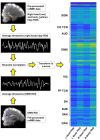Hippocampal Resting-State Functional Connectivity Patterns are More Closely Associated with Severity of Subjective Memory Decline than Whole Hippocampal and Subfield Volumes
- PMID: 32905008
- PMCID: PMC7463163
- DOI: 10.1093/texcom/tgaa019
Hippocampal Resting-State Functional Connectivity Patterns are More Closely Associated with Severity of Subjective Memory Decline than Whole Hippocampal and Subfield Volumes
Abstract
The goal of this study was to examine whether hippocampal volume or resting-state functional connectivity (rsFC) patterns are associated with subjective memory decline (SMD) in cognitively normal aged adults. Magnetic resonance imaging data from 53 participants (mean age: 71.9 years) of the Boston University Alzheimer's Disease Center registry were used in this cross-sectional study. Separate analyses treating SMD as a binary and continuous variable were performed. Subfield volumes were generated using FreeSurfer v6.0, and rsFC strength between the head and body of the hippocampus and the rest of the brain was calculated. Decreased left whole hippocampal volume and weaker rsFC strength between the right body of the hippocampus and the default mode network (DMN) were found in SMD+. Cognitive Change Index score was not correlated with volumetric measures but was inversely correlated with rsFC strength between the right body of the hippocampus and 6 brain networks, including the DMN, task control, and attentional networks. These findings suggest that hippocampal rsFC patterns reflect the current state of SMD in cognitively normal adults and may reflect subtle memory changes that standard neuropsychological tests are unable to capture.
Keywords: aging; brain connectomics; cognition; hippocampus; humans; magnetic resonance imaging.
© The Author(s) 2020. Published by Oxford University Press.
Figures




References
Grants and funding
LinkOut - more resources
Full Text Sources
